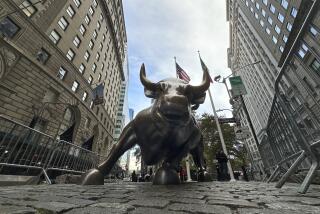Stocks Fall Into Tailspin in Final Hour of Trading : ‘Program Trading’ Cited for Volatile Session; Dow Index Declines 28.50
- Share via
NEW YORK — Some minor economic news, spectacularly magnified by the seemingly ubiquitous “program trading,” sent the Dow Jones industrial average into a late-session tailspin Thursday, producing a 28.86-point loss for the day.
After its second loss of more than 28 points in three days, the index of leading stocks closed Thursday at 1,766.40. The Dow index lost 28.50 points Tuesday.
Volume on the New York Stock Exchange was 148.23 million shares, up slightly from Wednesday’s 145.30 million.
Equities traders were nearly unanimous in blaming the computer trading programs used by major brokerages and institutions for Thursday’s decline. Most pinpointed the key moment at slightly after 3 p.m., when three major sell programs hit the stock market nearly simultaneously, producing a loss of 30 points in less than 25 minutes.
Jacques Theriot, senior vice president for equities at the financial house of Smith Barney, Harris Upham, said the market was up about 3 points when he left the firm’s trading floor for a 20-minute interview. By the time he returned, his staff was in turmoil and the Dow was down nearly 35 points.
At its extremes, the Dow index swept from a 15-point gain over the morning opening to a 35-point loss, an extraordinary 50-point spread. “It was a highly unusual day, to say the least,” Theriot remarked.
‘Spread’ Between Stocks, Futures
In program trading, large investors shift their money between stock index futures and selective “baskets” of individual stocks that are representative of the underlying indexes, a maneuver known as arbitrage. When the future trades at less than the index, the investors buy the future and sell the stocks; when it trades at the same price or for more than the index, they do the opposite.
In either case, the investors assure themselves of a short-term profit roughly equivalent to the spread between the two prices.
“Today, the spread of the future over the cash was as small as 30 cents, but that’s enough for the programs to buy the future and sell (stocks),” said William LeFevre, market strategist for the brokerage of Purcell, Graham & Co.
LeFevre noted that the market has been due for a stall for some time and, after its overheated rise, even a stutter was bound to produce a sharp reaction among the futures arbitrageurs. “It paused, and some people rang the bell,” he said.
The bond market slipped Thursday and crude oil futures rose, apparently in reaction to signals that the Reagan Administration considers the sharp drop in oil prices to be less than an unalloyed blessing for the economy. Money taken out of bonds flooded the stock index futures markets, driving their prices up and sparking the computerized programs.
Characteristically, among the stocks that took the largest hits Thursday were those commonly traded in index baskets. They included Philip Morris, which closed at 110, down 4 1/2; General Motors, down 2 7/8 to 80 1/8, and R. J. Reynolds, down 1 3/8 to 39.
To be sure, there were fundamental reasons for their declines: The looming start of a second tobacco product-liability trial on May 5 in Boston has depressed Philip Morris and Reynolds, and GM reported a 24% drop in auto sales for the second half of March. But many traders believe that their price moves were magnified by the sell programs.
Although program trading has been so much a feature of the stock market recently that some analysts attribute to it more than 200 points of the Dow index’s nearly 600-point rise since September, it took this week’s virtual back-to-back losses to generate a chorus of calls for government scrutiny of the arbitrage activity.
‘Unfortunate Scenario’
“It’s an unfortunate scenario,” Theriot said. “The Securities and Exchange Commission and the New York Stock Exchange have been looking at it, but to date their theory seems to be ‘let it run.’ ”
Meanwhile, on the over-the-counter market, Quotron shares rose 5/8 to 19 1/8 on heavy volume of 2.3 million shares amid rumors that Telerate might offer $23 a share to buy Quotron or that Citicorp was raising its pending $19-a-share bid by $1 a share. However, Quotron Chairman Milton E. Mohr denied the rumors, and a Citicorp spokesman said no announcements were pending.
Prominent losers among New York Stock Exchange blue chips included Merck, down 4 at 170 1/2; McDonald’s, down 2 3/4 at 94 1/2; Minnesota Mining & Manufacturing, down 2 at 100; Du Pont, down 1 1/2 at 73, and Eastman Kodak, down 1 1/2 at 60 1/8. Great Western Financial lost 1 5/8 to 41 3/4, and H. F. Ahmanson was down 1 1/8 at 64 3/8.
Bond prices pulled back amid uncertainty over prospects for oil prices and interest rates, the Associated Press reported.
The price of the bellwether 30-year Treasury bond tumbled about 1 points, or $12.50 for each $1,000 in face amount. The yield moved up to 7.48% from 7.39% late Wednesday.
In the secondary market for U.S. Treasury securities, prices of short-term governments fell by 1/8 point to 5/32 point, and intermediate maturities fell by 3/16 point to nearly a full point. A key 20-year bond lost 1 5/16 points.
In corporate trading, industrials were unchanged in moderate dealings and utilities pulled back 3/8 point in average activity.
More to Read
Inside the business of entertainment
The Wide Shot brings you news, analysis and insights on everything from streaming wars to production — and what it all means for the future.
You may occasionally receive promotional content from the Los Angeles Times.










